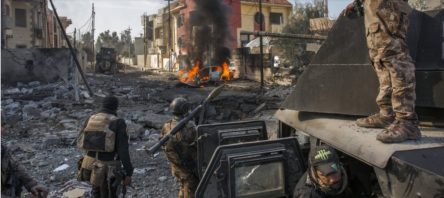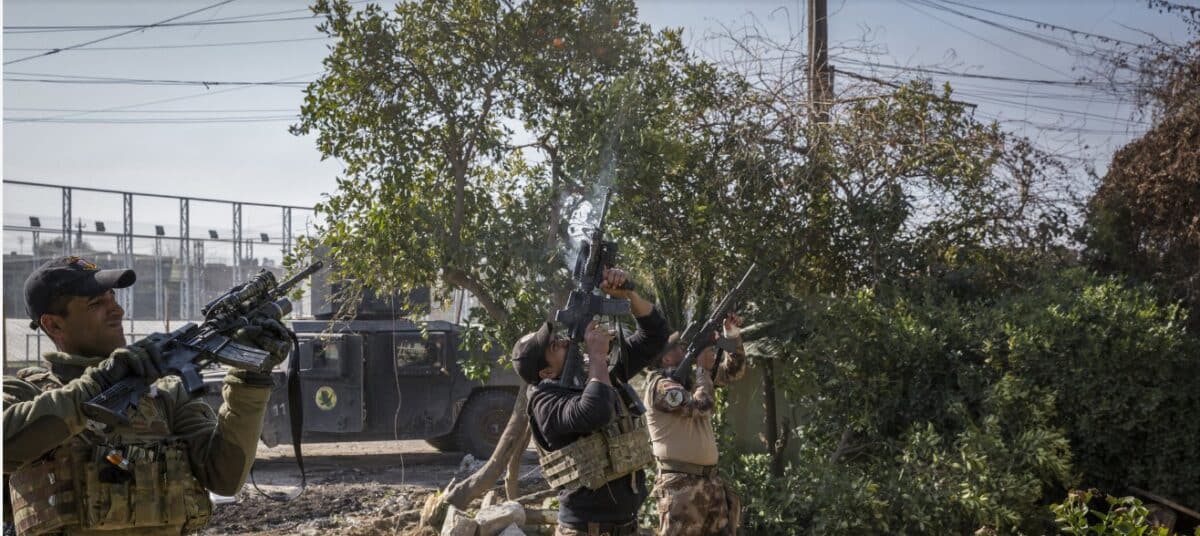كتب: ايفور بريكيت
An Iraqi soldier took up a position in a minaret. CreditIvor Prickett for The New York Times
بعد ثلاثة شهور من القتال، دخلت معركة استعادة الموصل من داعش فصلا جديدا، لكن ترسانة داعش الضحمة من السيارات المفخخة والاحزمة الناسفة لم تنضب بعد، فما زال اغلب المدنيين رهائن. مع يوم الجمعة استطاعت القوات الحكومية دفع مليشيا داعش عبر دجلة الذي يقسم المدينة الى قسمين، في نصر جزئي، تمت دعوة مجموعة صغيرة من الصحفيين من قبل الحكومة ليشاهدوا المدينة ويكتبوا من ارض المعركة.
كان المزاج العام للمقاتلين الحكوميين احتفاليا، فداعش تتراجع، لكن القتال لم ينته بعد، والخطر لا زال ماثلا، في الضفة الاخرى من دجلة – بعد مئات الامتار فقط هناك حوالي ثلاثة ارباع المليون يعيشون في تلك المنطقة- لازالت مليشيات داعش مسيطرة.
كنت ضمن وحدة للقوات الخاصة يقودها العقيد مهند سعد، ومع جنود هم من افضل المقاتلين العراقيين، لقد واجهوا الغام مصائد المغفلين التي زرعتها داعش كما واجهوا المسلحين والاكثر رعبا فيهم، اضافة الى السيارات المفخخة. في لحظة وجه الجنود بنادقهم للسماء لاسقاط طائرة مسيرة تحمل متفجرات، وبينما كان رتلنا المكون من دبابات وعربات مصفحة وجرافات يتجول في المدينة ، نزل فريق من الجنود لتفتيش البيوت حيث يعتقدون ان بعض اعضاء المليشيا يختبئون بها، ولانهم يخافون من الغام مصائد المغفلين كانوا يتحركون بحذر بين البنايات، يجدقون النظر في الخزائن وخلف المقاعد وكل ذلك بحذر كي لا يسببون انفجارات محتملة من عبوات مخفية.

المليشيات التي بقيت شرق الموصل كانت هناك لتقاتل حتى الموت. وببطء استطاع الجنود ان يعتقلوا اعضاء المليشيات واحدا تلو الآخر. لقد وجدت جثة احد اعضاء المليشيا ممددة في الطريق الى بيت عند البوابة في شارع مشجر في حي الاندلس الراقي. جثته المغبرة والمتحللة كانت مفارقة في حي جميل من احياء المدينة. خرج احد الاطفال بعمر عشر سنوات من البيت المجاور وبصعوبة اعطى المشهد الجنائزي على عتبة الباب نظرة اخرى.
رغم ان القتال الشرس قد انتهى، ظل الجنود في حالة استنفار وحذر من السيارات المفخخة وكان الخوف موجودا. عادة ما يأتي الراديو بأخبار حول وجود سيارة مفخخة قريبة من المكان، وبعد دقائق من التوتر سوف نسمع صوت صاروخ يطلقه التحالف من طائراته الحربية وتنفجر السيارة.
في نقطة ما تم الاخبار عن سيارة مشبوهة قريبة ومقابل موقعنا، لقد اخترقت السيارة صفا من السيارات المتوقفة بنية التوقف ثم تنفجر. دمرت كرة النار سيارتا همفي وجرحت اربعة جنود. هشمت القنبلة نوافذ مجاورة وخلفت حفرة بحجم صخرة ونثرت شظايا محترقة من العربة في الطابق الاول من بيت مجاور.
بعد فترة خرج المواطنون من بيوتهم شاحبين يبدو عليهم السقم من المكوث طويلا في البيوت، لتحية وشكر محرريهم. وحملق رجال كثر بحذر من نوافذ بيوتهم او من البوابات، بينما كانت النساء تلوح وتزغرد. اغلب عمل الجنود كان بطيئا، تطهير البيوت غرفة غرفة او تفتيش مسجد غير مكتمل البناء في حي الثقافة . عدد من القناصين اعتلوا الشرفات في احد الفنادق الفخمة من هناك يطلون على دجلة ويراقبون ويستهدفون اعداءهم من على بعد مئات الامتار. كثير من الناس القادرين على المغادرة سعوا الى ملجأ في مخيمات على طرف محافظة نينوى او كردستان العراقية.
The aftermath of a suicide car bombing in Andalus. Credit Ivor Prickett for The New York Times
MOSUL, Iraq — After three months of fighting, the battle to retake Mosul has entered a new chapter, but the Islamic State’s vast arsenal of car bombs and suicide vests is far from spent and most of the civilian population is still trapped.
By Friday, the government forces had pushed the militants across the Tigris River, which divides the city. With a partial victory in sight, a small group of journalists were invited by the government to report from the besieged city.
The mood among the troops was mostly celebratory: The Islamic State was on the run. But the fighting was far from over, and the danger still all too real. On the other side of the Tigris — just a few hundred yards away and home to 750,000 people — the militants were still in control.
Continue reading the main story
Photo
Families fleeing Al Thaqafa. Credit Ivor Prickett for The New York Times
I was embedded with a special forces unit, led by Staff Col. Muhanad Saad. These soldiers are among the Iraqi Army’s best troops. They faced Islamic State booby traps, gunmen and, perhaps scariest of all, suicide car bombers. At one point, the troops pointed their rifles skyward to shoot down an ISIS drone carrying an explosive payload.
Continue reading the main story
Photo
Iraqi soldiers taking aim at an Islamic State drone. Credit Ivor Prickett for The New York Times
As our convoy of tanks, armor-plated bulldozers and Humvees snaked through the city, small groups of commandos peeled off to search houses in which they believed militants were hiding. Fearing booby traps, they moved carefully through buildings, peering into cupboards and behind couches, always careful not to move anything that could trigger a makeshift explosive.
The militants who remained in eastern Mosul were there to fight to the death. Slowly, the soldiers picked off fighters one by one. The body of one fighter was found sprawled in the gated driveway of a home on a leafy street in the upscale Andalus neighborhood. His dusty, mangled body was at odds with what still was a beautiful and serene part of the city.
A boy, no more than 10, appeared from the house next door and hardly gave the macabre scene on his doorstep a second glance.
Continue reading the main story
Photo
The body of an Islamic State fighter in Andalus. Credit Ivor Prickett for The New York Times
Though much of the worst fighting was over, the soldiers were still on alert for suicide car bombers, a fear well founded.
Occasionally, a radio would crackle with news that a car bomber had been spotted nearby. After a few tense minutes, we would hear the sound of a missile fired by a coalition warplane and the car exploding.
At one point, a suspicious car was reported nearby and heading straight for our position.
The bomber had broken through a line of parked cars, intended to stop just such an attack, and detonated his explosives. The fireball destroyed two Humvees and injured four soldiers.
The bomb shattered nearby windows, left a crater the size of a boulder, and threw burning pieces of the vehicle into the first floor of a nearby house.
Continue reading the main story
Photo
An Iraqi soldier moving into position. Credit Ivor Prickett for The New York Times
Slowly, residents emerged from their homes to greet and thank their liberators. Visibly pale and wan, presumably from spending days indoors away from the fighting, men warily peered from their homes’ front gates, while the women and girls inside waved and cried out.
Continue reading the main story
Photo
A family fleeing minutes after a car bombing. Credit Ivor Prickett for The New York Times
Much of the soldiers’ work was slow going. Clearing houses, room by room. Or searching the huge, unfinished mosque in Al Thaqafa neighborhood.
Continue reading the main story
Photo
Iraqi soldiers cleared the mosque in Al Thaqafa. Credit Ivor Prickett for The New York Times
Several military snipers took up positions on the balconies of the once-luxurious Nineveh International Hotel. From there they could look across the Tigris, monitoring and targeting their enemy several hundred yards away.
Continue reading the main story
Photo
An Iraqi soldier at the Nineveh International Hotel. Credit Ivor Prickett for The New York Times
Many of the residents able to leave have sought refuge at the camps on the edge of Nineveh Province and in Iraqi Kurdistan.
Continue reading the main story
Photo
Inside the unfinished mosque in Al Thaqafa. Credit Ivor Prickett for The New York Times
The humanitarian situation in eastern Mosul is dire. Most aid organizations have avoided the front lines because of security concerns.
Thousands of people have fled eastern Mosul as the fighting has intensified and the front lines have shifted. All five of the Tigris River bridges that connected the city were destroyed in airstrikes at the end of last year.
الوضع الانساني لئيم جدا في شرق الموصل، معظم هيئات الاغاثة تتجنب جطوط المواجهة لدواعي الامن، آلاف من المدنيين غادروا شرق الموصل عندما اشتد القتال وتغيرت خطوط المواجهة لقد دمرت الجسور الخمسة التي كانت تربط شطري المدينة في ضربات جوية قبل عام. المرافق العامة كالماء والكهرباء غير موجودة في معظم المناطق كما تفتقر المدينة الى الرعاية الطبية الاساسية.
Continue reading the main story
Photo
A damaged bridge to Al Sukar, a neighborhood that has been retaken. Credit Ivor Prickett for The New York Times
Utilities like running water and electricity are nonexistent in many districts, and the city lacks basic medical care.
Continue reading the main story
Photo
An injured man was transferred to an ambulance. Credit Ivor Prickett for The New York Times
As the battle moves west, humanitarian organizations are worried about the 750,000 people still under Islamic State control in the western half of the city.
Continue reading the main story
Photo
A home in eastern Mosul damaged by a car bomb. Credit Ivor Prickett for The New York Times
Although Iraqi forces and coalition airstrikes have tried to avoid civilian casualties, there is no avoiding the fact that this fighting is taking place in a heavily populated urban environment.
Continue reading the main story
Photo
ومع تحرك المعركة باتجاه الغرب، يبدو القلق على منظمات الاغاثة الانسانية بالنسبة لثلاثة ارباع المليون الذين هم رهينة في يد داعش. ورغم ان القوات العراقية وضربات التحالف الجوية قد حاولت تجنب اصابة المدنيين، فان هذا التجنب لم يحدث بسبب الكثافة العالية للسكان في المدينة.
A car was used to block car bombers in Al Thaqafa. Credit Ivor Prickett for The New York Times
One man, Khalid Mohammed Qassim, 42, wanted to check on the flour factory where he had worked for 15 years as a driver. While walking, he and his 16-year-old son, Zaid Khalid Mohammed, were killed when they were struck by a roadside bomb, Mr. Qassim’s nephew said.
Continue reading the main story
Photo
احد الرجال وهو خالد محمد قاسم (42 عاما) اراد ان يتفقد مصنع الطحين حيث عمل 15 عاما كسائق فيه، وبينما كان يمشي مع ابنه زياد البالغ 16 عاما قتلا جراء انفجار عبوة جانبية كما يقول ابن شقيق خالد، لقد دفنا معا في مقبرة في ضاجية قوجالي حيث قال حفارو القبور انهم يدفنون عشرة اشخاص في اليوم، ومع انتشار القتال نحو الغرب سيكون عملهم اكثر كثافة.
An Iraqi soldier took up a position in a minaret. Credit Ivor Prickett for The New York Times
They were buried together in a cemetery in Gogjali, a suburb, where the gravediggers say they bury about 10 people every day. As fighting spreads to the western half of the city, they said, they will soon be busier.
Continue reading the main story
Photo




